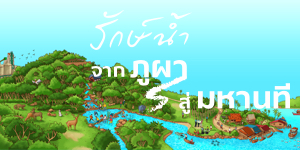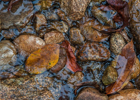Retracing the Footsteps of Royal Initiatives through SCG’s “Conserving Water From Mountain to Mighty River” Significant Milestones in Promoting Innovation for Sustainable Water Management and Revitalizing Strong Community
“Because water is essential for all living things. Where there is water, there is life.” SCG has collaborated with communities and networks for over ten years of the journey toward sustainable water management.
The Beginning of Journey Toward Environmental Sustainability and Livelihood
SCG has embraced a royal initiative “From Mountain to Mighty River” and incorporated circular economy principles into the scheme to heighten the project “Conserving Water for Tomorrow” that had been in place for more than 10 years to the initiative “Conserving Water from Mountain to Mighty River” (or “Conserving Water from Upstream to Downstream”) in 2018. The scheme aims to expand the success of effective water management strategies of each area by establishing feasible water strategies in the upstream area to ensure ample midstream capacity and maintain a sustainable livelihood in the downstream areas through public participation. The efforts are to encourage a truly community-based water management system, along with forging more collaborations with local authorities, volunteers, employees to build a strong coalition and knowledge sharing network for coherent water management.
“Check Dam,” A Model of Upstream Recovery
Starting at the upstream area at Mae Ta district in Lampang, check dams were introduced as part of the recovery programs to help mitigate problems of drought, flood, and wildfire. The program has expanded to Chae Hom district in Lampang where the scheme has shifted the goals from not only seeking water but also storing water. The effort has led to the construction of Sra Puang ponds at the foot of the mountain where the water storage works by connecting a string of reservoirs to ensure adequate water supply for farmland with low water holding capacity soils. The community can grow drought-tolerant plants such as pumpkin, zucchini, yardlong bean and bitter gourd which allows the cultivation up to 7 times a year, bringing over 18 million Baht in income per year to the community. The Sra Puang ponds also distribute water covering the agricultural area of 500 rai with the help of “Monkey Cheek” strategy, generating over 100,000 Baht of income per household a year. The water strategy also stores about 134,000 cubic meters of reserve water for drought season usage where the community can manage water systematically and develop the strategy into eco-tourism to create more jobs and income sustainably.
The project doesn’t carry out merely in the northern region. Check dams were as well initiated in Tham Yai sub-district, Thung Song district in Nakhon Si Thammarat where local communities, networks, and SCG came together to construct check dams to preserve and restore upstream forest in Nakhon Si Thammarat Range, a water source of Trang Basin. The same water strategy scheme was expanded to Sai Yok district in Kanchanaburi where was facing drought issues due to ongoing forest clearance to expand farmland and topsoil erosion. As a result, check dams were introduced as tools to delay water outflow and revive food and income sources for villagers.
“The check dam helps return ecological balance, and the forest is like a supermarket where the local people can seek forest products to cook for the family as well as selling them to earn more income. On top of that, it is unbelievable to see people coming together to build check dams. This helps bring our community together so we can talk and understand each other,” said Headman Krut or Mr. Tanyew Wachirapanwichan, Ban Yangthon Forest Community chairman.
“Monkey Cheek,” Retaining Water in Midstream Areas and Reviving Agricultural Production
For midstream area, SCG teamed up with Phu Tham Phu Ka Tae Forest Community in Wang Noi sub-district in Khon Kaen, a model community that implements water management based on royal initiative and programs of Utokapat Foundation Under Royal Patronage of H.M. the King. The joint effort has expanded the implementation of sustainable water management to Ban Non Khao in Wang Noi district in Khon Kaen by introducing “Monkey Cheek” as water retention area receiving water run-off and connect Chi River to agricultural fields. This effort helps retain water and diminish drought and flood risks of 250 rai of the farmland. The areas can also be used as fishery farms which have helped generate about 30,000 Baht in income a year to community and mitigate inadequate household water supply.
“SCG Fish Home”, Achievement at Downstream Area
At the downstream area, SCG has used PE100 pipe leftover from manufacturing tests for polyethylene moulding as materials for fish homes to revive and preserve eastern marine and coastal ecosystem and provide hatcheries for small aquatic species, restoring the abundance of Thai oceans. At present, over 1,600 fish homes have been installed in Rayong, Chonburi, and Chanthaburi covering over 40 sq.km to revitalize the abundance of marine biodiversity in which 172 species of economic aquatic animals and marine ornamental fish were introduced.
“The project’s core driver in past six years is strong fisherfolk community that everyone comes together to build fish homes and continuously look after the conservation area on top of spirits of over 11,500 volunteers that have joined the project from the beginning. At present, SCG has carried out experiments to transform plastic waste collected in the ocean and communities through a recycling process to make pipes for fish homes. The effort is based on the circular economy,” said Mr. Cholanat Yanaranop, Executive Vice President of SCG and Chairman of SCG Sustainable Development Committee.
Furthermore, in the southern coastal areas, as local fishers of Mod Ta Noi village in Koh Libong sub-district, Kan Tang district in Trang are not able to go out to the sea for fishing during the monsoon period, they move to fish in canal but found little amount of fish due to the loss of abundant habitats. Hence, SCG teamed up with the community providing marine habitats by constructing round concrete artificial reefs made of innovative high-grade durable cement for structural work with holes in several sizes where fish can swim through and find shelter. SCG also launched mangrove reforestation and improve seagrass habitats to support dugongs and other endangered marine animals.
Strengthen Communities with Societal Innovation
With expertise and long experience in community participatory water management, SCG introduced “Concrete Fabric Innovation,” an innovative product that combines cement and canvas technology offering uncompromising strength for various applications from Cement and Building Materials Business to help alleviate drought problems. The innovation was applied in Sra Puang project in Saphae, Lampang to help improve water holding capacity in sandy soil areas.
Furthermore, to provide marine habitats in southern coastal areas, SCG has installed fish homes made of “Innovative and Special-Grade Durable Cement for Structural Work” with improved sulfate and chloride resistance that ensure longer durability in seawater. The product is certified safety and environmentally friendly with increased strength and durability thereby minimizing crumbling and breakage to help reduce marine waste.
At the same time, “Innovative Fish Home” made of PE100 pipe leftover from manufacturing tests for polyethylene moulding of Chemicals Business is installed in coastal areas of Rayong to create nursery habitats. PE100 pipes have been proven safety for water distribution. A decline in fish stocks in coastal areas have been recovered.
New Generation Network, Volunteers for Sustainability
All conservation efforts throughout 2018 were not merely driven by local communities, government sector, and SCG employees but also Young Rak Nam group, a group of 80 young people from different educational institutions traveling across the country with SCG. The group has exchanged knowledge on water management and learned hands-on experience as well as success stories of water management. This youth engagement will help continue and advance the royal initiative's sustainable water management efforts forward.
“It’s beyond belief that a small beginning step of building check dams with joint efforts of the local people, friends, students, and volunteers could result in abundance increase of forest. I could not imagine this land to have drought and flooding problems. If there is such an activity next time, I will be part of it to help improve Thailand,” said Miss Chopaka Pojanasukhon, a 4th-year student from Mae Fah Luang University, a young volunteer from Young Rak Nam Group.
Next Step of “Conserving Water From Mountain to Mighty River”
SCG will continue the project “Conserving Water From Mountain to Mighty River” in various areas throughout the country to achieve conservation goals by 2020. In the past years, we have launched a series of initiatives collaborating with communities and volunteers. 83,200 check dams have been built, and SCG will continue to pursue building 100,000 check dams covering the entire upstream areas nationwide. 7 Sra Puang ponds at the foot of the mountain have been achieved thereby establishing 20 Sra Puang ponds are among target goals. For midstream area, 8 areas are installed with Monkey Cheek water strategy which is on track to cover 20 target areas. For downstream areas, 1,900 fish homes have been installed which is on the path toward placing a total of 2,600 fish homes. SCG has a strong commitment to promoting the community’s ability to develop and transform local produce into value-added products to create jobs and year-round income. For more information, please visit the website www.scg.com/lovewater
We believe that community participation is vital for development toward sustainability. Building strong networks is key to establish good upstream management that brings abundance to downstream areas, resulting in a balance that improves people’s wellbeing. SCG is striving to carry on projects with communities in different areas nationwide along with conveying and furthering conservation efforts as it’s a major asset of all lives to live sustainably.
More Images





